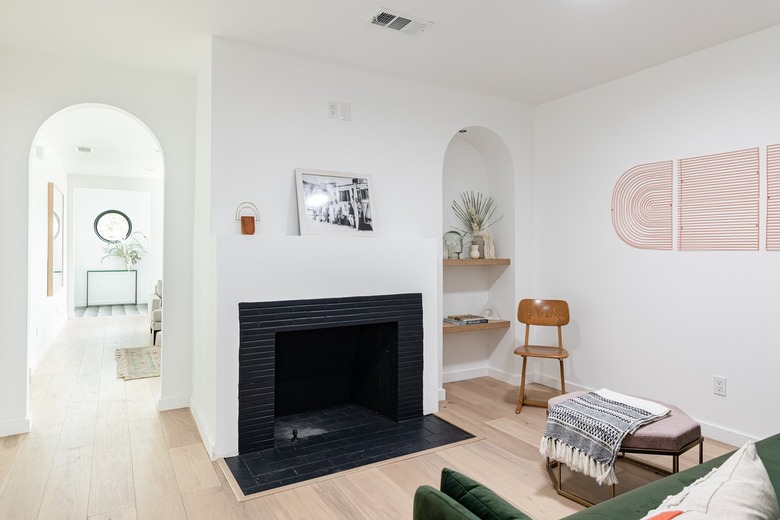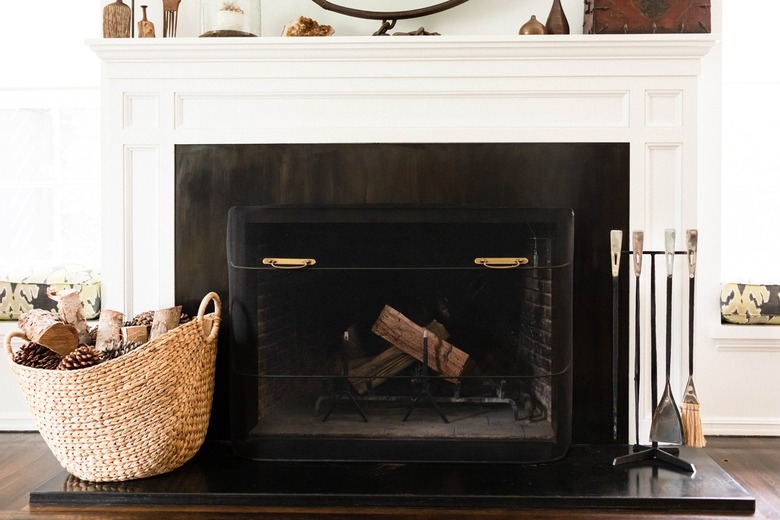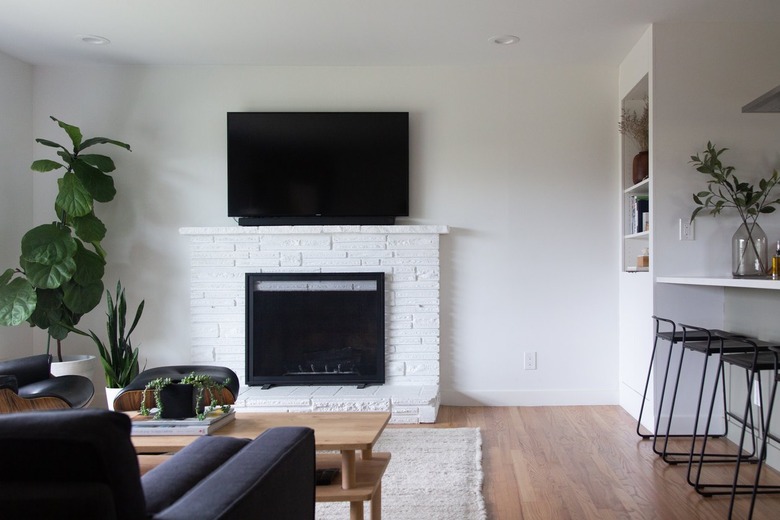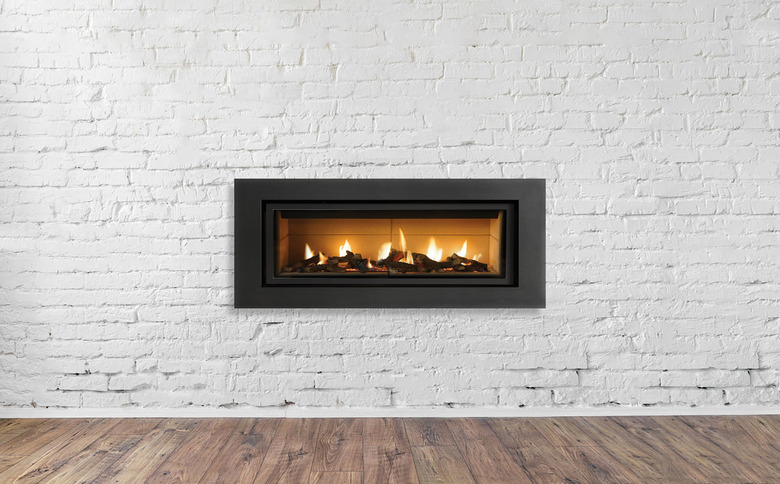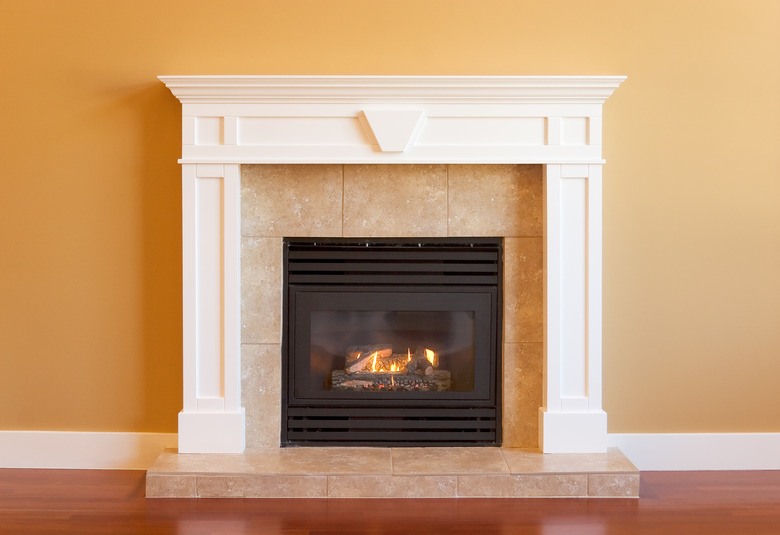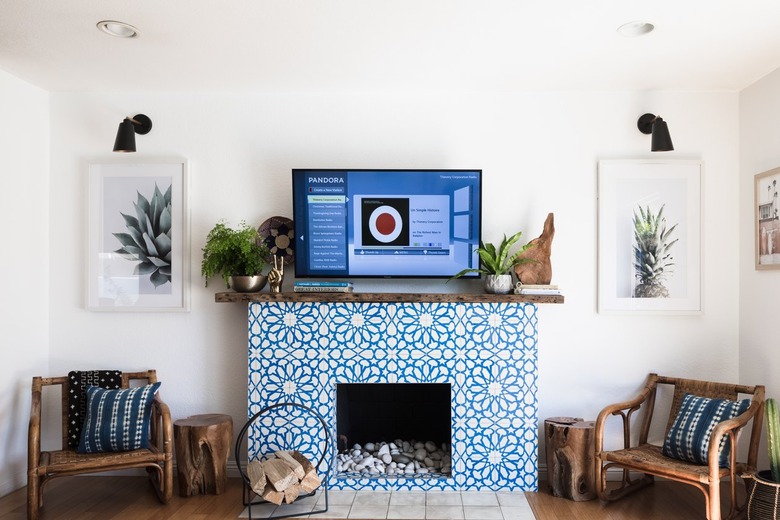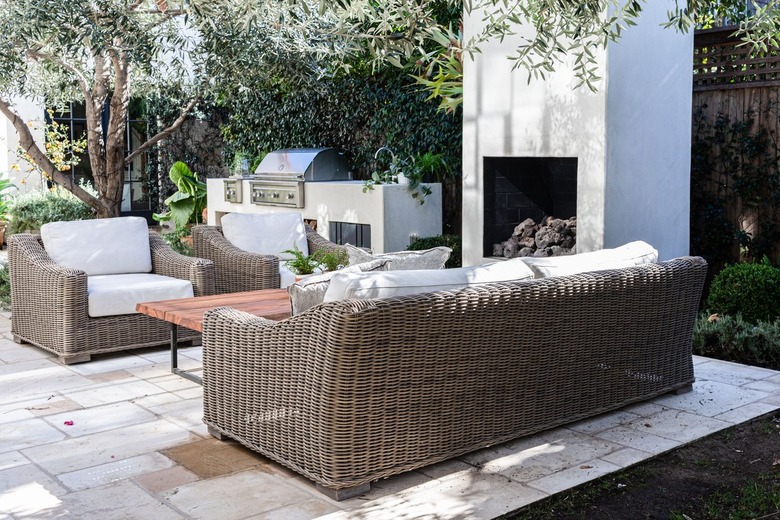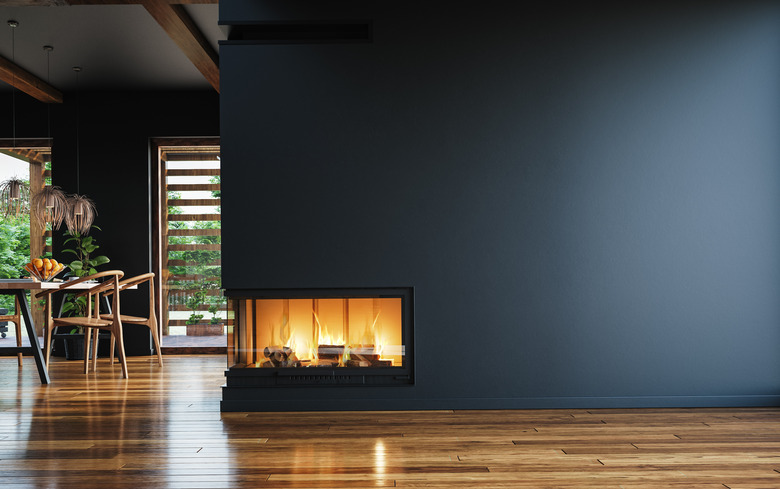The 8 Types Of Gas Fireplaces
If you're looking to up the cozy factor in your space while still keeping things relatively low maintenance, a gas fireplace is your best bet. Start a fire without having to light a match — gas fireplaces turn on at the flip of a switch.
Aside from the fact that they use gas to fuel the flames, not all gas fireplaces are the same. One key difference between types of gas fireplaces is in how they're vented. Some require venting vertically and through the roof, similar to a wood fireplace venting through a chimney, while others sometimes vent through a wall or even over a large run of winding duct or vent work. Beyond venting, gas fireplaces may also vary based on color, style, whether they have one or more viewing areas, and whether they're installed indoors or outdoors.
1. Natural or B-Vent Gas Fireplace
A natural-vent gas fireplace, sometimes called a B-vent gas fireplace, requires a vertical shaft for ventilation, while some other types do not. Air from inside the room creates the combustion needed for the flames.This type of fireplace creates relatively large flames, so if you're using a fireplace for the ambiance, this is a good option. Some heat loss occurs with B-vent setups and it's subject to down drafts from outside, so it isn't the best option if you're using the fireplace primarily for heating purposes.
A B-vent gas fireplace requires venting all the way through the roof, so it isn't ideal as a new installation in a multistory home that doesn't have an existing fireplace and chimney combination or that doesn't have any other easy path to install B-vent piping to the roof. Installing one may involve hefty labor costs if there's not a clear means through to the roof. Converting a wood-burning fireplace to a gas one is the most economical way to add a B-vent since you won't need to add any vent or duct work or drill through the roof. B-vent types of gas fireplaces may be harder to find than a few other choices, as some manufacturers are moving away from them and opting for the more versatile and efficient direct-vent gas fireplace instead.
Where to Install
A B-vent fireplace should be installed in a space with room to vent all the way through to the roof. You may need to install this yourself or use an existing fireplace and chimney combination.
2. Direct-Vent Gas Fireplace
Unlike an old-school wood fireplace, a direct-vent type of gas fireplace doesn't require a vertical chimney or shaft for ventilation. A direct-vent gas fireplace may be vented through a wall or vertically through a roof if that option works better for your home's layout. Venting through a side wall allows for installation in any room, including the bedroom, basement, or bathroom. A direct-vent fireplace has a sealed firebox, which makes it fairly efficient. It also has a barrier screen in front to prevent accidental burns.
The type of chimney pipe used for direct-vent fireplaces costs a bit more than a similar length of B-vent chimney pipe, but in many cases, you won't need as long of a run since you can vent through a wall. The flue setup in a direct-vent fireplace has two separate chambers. One brings in fresh air from outdoors for combustion while the other side is the vent, resulting in an efficient system that does not use indoor air for combustion. The firebox seals itself when not in use so cold air doesn't come through the vent and into your home. No electricity is required to use a direct-vent system, as natural principles of cold air sinking and warm air rising create the ideal airflow situation needed for the fireplace to emit heat and to ventilate itself without heat loss.
Where to Install
Because you can vent direct-vent fireplaces through a wall, you can install it virtually anywhere in your home, even in the basement.
3. Power-Vent Gas Fireplace
A power-vent gas fireplace works in much the same way as its direct-vent counterpart except it adds an electric fan to aid in air circulation. Power-vent fireplaces aren't necessary in small homes in most situations. Instead, they're used for long or winding vent runs, such as in a large, warehouse-style homes or in commercial settings where natural ventilation alone wouldn't be enough for ample air circulation. As the name implies, a power-vent fireplace requires power, so there's no using this fireplace for heat output during a power outage.
Where to Install
Install a power-vent gas fireplace in a large, open room that needs airflow or in a commercial building.
4. Vent-Free Gas Fireplace
A vent-free or ventless gas fireplace doesn't require a vent for exhaust fumes, which is both a benefit and a drawback. The benefit is that no added vent piping is needed, but the drawback is the level of carbon monoxide and other chemicals that may end up in the room if the unit is not in optimal working condition. Some states ban the use of ventless gas fireplaces or logs as well as ventless gas heaters due to such potentially harmful gases. If you opt for this type of gas fireplace, make sure you have a carbon monoxide detector (or two).
Since there's no vent to the outdoors, there's no way for heat to escape, and all of the heat from the flames stays in your home. This also means a ventless unit uses less gas than a similar vented option in many cases, saving you money on your gas bill. The flame tends to be more blue than flames on actual logs, so it may seem less realistic than a wood fire. Ventless gas logs also can't be repositioned, and you can't customize or upgrade them. A ventless fireplace emits odors that may trigger issues for some people who are sensitive to them, and since water vapor is a product of gas combustion, it raises the humidity in the room.
Where to Install
Ventless gas fireplaces do not need a vent for exhaust fumes, meaning you can install them practically anywhere. But we suggest installing one in a room with a window or door to the outside because ventless gas fireplaces tend to emit a lot of heat and, sometimes, odors.This way, you can crack a window when it starts to get too hot or smell funny.
5. Gas Fireplace Insert
A gas fireplace insert is a device that fits inside an existing wood-burning fireplace, turning it into a gas-burning one instead. These come in assorted sizes and styles, allowing you to somewhat change the look of the existing wood fireplace. For further customization, choices exist for the appearance of the inner panels, such as red brick or reflective black brick. Once installed, the setup looks from afar as though it has always been a gas-burning fireplace.
A gas fireplace insert uses direct-vent technology, which means it still needs intake and exhaust pipes even though the entire setup fits within an existing fireplace and chimney. It's a major project best left to the pros, as you'll have to clean the chimney, install these pipes, and add a gas line to fuel the insert. Any project requiring a new gas line is best left to a professional. Have the chimney professionally inspected as well before converting the fireplace since the chimney must be in fairly good shape for the conversion.
Where to Install
Install a gas fireplace insert in an already-established fireplace. You can use them to convert an old wood-burning fireplace to gas.
6. Gas Log Set
A gas log set is used to convert a wood-burning fireplace to a gas one without the boxy structure of an insert surrounding it. These may be either direct-vent or ventless, but as with other ventless fireplaces, first be sure they're allowed in your area. Gas log sets cost far less than gas fireplace inserts since there's not much to them, but they're also less efficient. As with the gas fireplace insert, have the chimney professionally inspected for any issues before installation.
Though a gas log set is relatively inexpensive and easy to handle, it still requires a professional gas hookup. Additional or replacement logs are available for some sets, allowing some level of customization to make the fireplace look more like a wood-burning one even when not in use.
Where to Install
Place a gas log set in an existing wood-burning fireplace to convert it into a gas fireplace.
7. Outdoor Gas Fireplace
If the patio is your favorite place to entertain or to spend time relaxing, an outdoor gas fireplace may make it even more enjoyable. As with gas-powered fire pits, the design options are practically limitless for outdoor gas fireplaces. But first, check your local building and fire codes to ensure any form of outdoor fire is allowed in your community and in the location you envision. Most codes have rules as to how far such a structure must be from the property line and, in the case of flames, how far from existing structures.
A permanent outdoor fireplace usually requires connection to an underground gas line and a professional to hook it up. You may need to install a run of gas pipe if the fireplace is a good distance from any accessible gas line on your property. Propane is another option for fueling an outdoor gas fireplace; in some cases, these use regular propane tanks you might use for a portable patio heater or a gas grill.
Where to Install
Install an outdoor gas fireplace on your patio or deck in accordance with your local building and fire codes.
8. See-Through Gas Fireplace
A see-through gas fireplace isn't transparent, but it has two "fronts" and no back wall. This allows for viewing straight through the fireplace from one room to another or from one area of a large, open room to another. This type of fireplace is usually a direct-vent design and sometimes stands on its own or along interior walls rather than exterior walls. Depending on the installation location, this may require some creative chimney pipe installation, but since it's a direct-vent unit, the pipes don't necessarily have to travel up through the ceiling or roof.
Installing a see-through fireplace may require significant modification to your home's interior, such as knocking out part of an interior wall to install so the fireplace is visible from two separate rooms typically divided by that same wall. Modifying your home's structure likely requires permits, so check your local building codes to determine what's necessary to ensure compliance.
See-through fireplaces often come with more style options than the classic wood or gas fireplace, including the bed material at the base of the flames. Instead of logs, the bed material may look like translucent blue glass or river rocks, for instance. A corner design offers a view from two adjacent sides rather than a view straight through the unit. Some see-through fireplaces also mount a bit higher into a wall for maximum viewing pleasure, as you may have noticed in some restaurants or hotel lobbies. This type isn't limited to the usual square fireplace design; some may be rather long and offer only a couple feet of viewing area from top to bottom.
Where to Install
You can install see-through fireplaces in any large rooms with half walls or between two rooms in your house.
